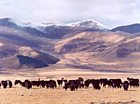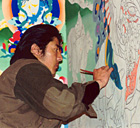
The eastern Tibetan provinces of Kham and Amdo are quite geographically distinct from the rest of Tibet, with verdant forests, sweeping pasturelands and dramatic river gorges. It is here that three of Asia’s great rivers have their headwaters, as the Yangtze, Mekong, and Salaween begin their precipitous descent into China and Southeast Asia. Etching their signatures deep into the hillsides, the rivers have created some of the most impressive gorges on earth. It is also in this region that the mighty Tsangpo, which has its origins in far-off Western Tibet, cuts its way between the massive snow-capped peaks of Gyala Pelri and Namche Barwa, doubles back on itself and reemerges as the Brahmaputra, plummeting via a series of dramatic waterfalls into India.
Aside from the splendor of its natural scenery, Kham and Amdo are home to some of Tibet’s most intriguing people. Amdo is the ancestral home of His Holiness the 14th Dalai Lama. Kham is home to the nomadic Khampa, an extremely devout yet fierce people who sacrificed much in the resistance to China’s incursion into Tibet. With their rakish cowboy hats and rough and tumble ways, the Khampa men and their nomadic lifestyle inspires visions of the American West in the 19th Century. You can experience the rare opportunity to interact with this wonderful group of people during a visit to the annual Horse Festival in Litang. Here, in an atmosphere reminiscent of an old-west carnival, the nomadic peoples of Eastern Tibet gather to trade, compete, show off their horsemanship, and, most importantly, eat, drink, and be merry.
Whether your tastes are trekking, touring, or just mingling with the amazingly genuine people, Eastern Tibet is an enchanting land that you won’t soon forget.
Explore Eastern Tibet on these itineraries or call to plan your
private journey.
|

Monastery doorway

Mologan Plateau, Kham
Photo: Gillian Marshall

Monastery painter
Photo: Gillian Marshall
|